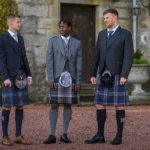
Sweaters, those cozy and versatile pieces of clothing, have a story to tell. From their humble beginnings as functional garments designed to keep people warm in cold weather to their evolution into fashion statements, sweaters have woven themselves into the fabric of our lives. In this exploration, we delve into 25 intriguing historical facts and numerical trivia about sweaters, each shedding light on the unique and ever-evolving world of knitwear. From the origin of the term “sweater” to record-breaking feats and cultural icons, the journey through these tidbits promises to unravel the rich tapestry of a garment that has stood the test of time.
The term “sweater” is believed to have originated from the 19th-century sport of rowing, where athletes would “sweat” in their knitwear. Sweaters, in their early forms, were designed to provide warmth and comfort, particularly in chilly weather or during physical activities. The connection to rowing comes from the way these knit garments would keep rowers warm while they exerted themselves, leading to the slang term “sweater” that has since become commonplace.
The first modern sweaters as we know them today were created in the early 20th century. While knitwear had been around for centuries, the transition to the modern sweater we recognize began in the early 1900s. Advances in knitting technology, patterns, and styles allowed for a more tailored and comfortable fit, making sweaters a staple in wardrobes worldwide.
The first patented sweater design was registered by the Icelandic immigrant Peter Gudjohnsen in 1913. This patent reflects the growing innovation and commercialization of sweater designs during the early 20th century. Gudjohnsen’s design likely contributed to the broader evolution of sweater styles.
The world’s largest sweater, as of my last update in 2021, was created in 2016 and measured 26 feet tall and 45 feet wide. This colossal sweater stands as a testament to human creativity and showcases the versatility of knitwear, even on a grand scale.
The world’s most expensive sweater, “The Row” designed by Mary-Kate and Ashley Olsen, was priced at $5,920. This exemplifies how sweaters can range from affordable and functional to high-end fashion items, blending art and utility in the world of fashion.
Mr. Rogers, the beloved children’s TV host, was known for wearing cardigan sweaters in his show “Mister Rogers’ Neighborhood.” His iconic cardigans are a symbol of his warmth and comfort, mirroring the sentiment of his show, which aimed to create a safe and comforting space for children.
The iconic Christmas sweater with reindeer, snowflakes, and other holiday motifs gained popularity in the 1980s. These festive and often quirky sweaters have become a staple of holiday celebrations, demonstrating how fashion can be a source of fun and communal spirit.
The Guinness World Record for the most people wearing Christmas sweaters in one place was set in 2017 when 3,473 people gathered in Kansas City. This record underscores the global enthusiasm for Christmas sweaters and the camaraderie that comes from donning these whimsical garments during the holiday season.
The thickness of a sweater’s yarn is measured in units called “ply,” with single-ply, double-ply, and so on. This technical detail provides insight into the quality and warmth of a sweater, with higher ply numbers generally indicating a thicker, more insulating fabric.
Aran sweaters, originating from the Aran Islands of Ireland, are known for their intricate cable-knit patterns. These patterns have unique historical and familial significance, as each design was often associated with a specific family or region on the Aran Islands, and they served to identify lost fishermen at sea. The detailed patterns have made Aran sweaters a symbol of Irish craftsmanship and heritage.
The concept of the “ugly sweater” party became popular in the early 21st century, with people intentionally wearing garish, gaudy sweaters. Ugly sweater parties are a lighthearted way to embrace the kitschy side of fashion and have gained traction as a festive holiday tradition, fostering creativity and humor.
The term “turtleneck” refers to a high, folded collar that covers the neck, and it became popular in the mid-20th century. Turtleneck sweaters are celebrated for their classic, timeless style and their practicality in keeping the neck warm, and they’ve been favored by fashion icons like Steve Jobs.
“Cashmere” is a luxury fiber often used to make sweaters, and it comes from the fine undercoat of cashmere goats. The rarity of cashmere and its exceptional softness and warmth make it a sought-after material for premium sweaters, often commanding high prices due to the labor-intensive process of harvesting the fiber.
In 2019, a cashmere sweater by Loro Piana was sold for a record $42,000 at an auction. This staggering price attests to the exclusivity and prestige associated with high-end cashmere garments, and it underlines the appreciation for fine craftsmanship in the world of fashion.
“Cardigan” sweaters are named after James Brudenell, the 7th Earl of Cardigan, who was a British military officer during the Crimean War. This historical connection adds a touch of intrigue to the name, as it’s derived from the attire worn by a notable historical figure.
The iconic red cardigan worn by Kurt Cobain during Nirvana’s MTV Unplugged performance in 1993 was auctioned for $334,000 in 2019. This sweater carries deep cultural significance, as it is a part of rock and music history, and its high auction price reflects the enduring legacy of Kurt Cobain and Nirvana.
The Fair Isle sweater, known for its colorful patterns, originated in Fair Isle, a small island in Scotland. These patterns have a charming, rustic appeal and have become a distinctive style in knitwear, showcasing the artistry of Fair Isle’s crafters.
The “Gansey” sweater, traditionally worn by fishermen, is designed with textured stitches to provide extra warmth and durability. These practical and hard-wearing garments represent the cultural connection between knitting and maritime industries.
On February 20, 2020, a group in Sweden set a record for the most people simultaneously knitting for an hour, with 989 participants. This event reflects the enduring popularity of knitting and its capacity to bring people together in a shared, creative endeavor.
The term “sweater weather” is often used to describe the cool, comfortable temperatures of autumn. This phrase captures the cozy, comforting feeling associated with wearing sweaters when the air turns crisp and hints at the strong connection between clothing and the changing seasons.
In 2007, researchers found a 1,700-year-old sweater in Egypt, making it one of the oldest surviving knitted items in the world. This remarkable discovery sheds light on the long history of knitting as a craft and its importance in clothing people across different cultures and time periods.
The world’s smallest sweater, measuring just 0.4 inches (1 cm) in width, was created for a Barbie doll. This playful fact highlights the intricate skill and attention to detail that goes into even the tiniest of garments.
The idea of knitting sweaters for penguins gained popularity in the mid-2000s as a way to help birds affected by oil spills. These “penguin sweaters” not only provide warmth and protection but also offer a heartwarming example of human compassion and ingenuity in the face of environmental challenges.
The knitting machine, invented by William Lee in 1589, played a crucial role in the mass production of knitwear. Lee’s invention revolutionized the textile industry, making it possible to create sweaters and other knit garments more efficiently and on a larger scale.
Sweaters can vary greatly in weight, with lightweight summer sweaters typically weighing around 6-8 ounces, while heavy winter sweaters can weigh up to 2 pounds or more. This diversity in weight highlights the adaptability of sweaters to various seasons and climates, ensuring comfort and style year-round.









